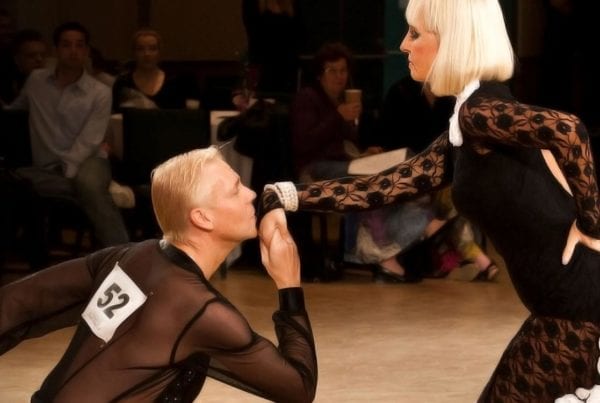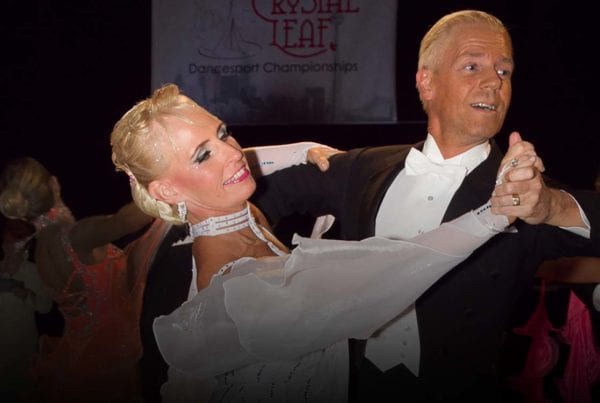A few years ago, I was watching a ballroom dance competition on television with my aunt in Germany. As we watched the couples dance the Slow Foxtrot, my aunt turned to me and said, “It looks like the couples are going for a stroll in the moonlight, doesn’t it?”
I love the Slow Foxtrot. It’s considered the most challenging of the Standard dances because of the control required to dance well, but everything about it, from the music to the quality of the movement, is beautiful.
The steps are simple in concept yet surprisingly challenging. It’s said that the Feather Step is called the “million dollar step” not because it looks like a million dollars but because it costs a million dollars in lessons to learn how to dance it well. When danced properly, the bodies glide together as if on ice skates. While the feet move at different speeds, the body moves continuously, flowing smoothly with long, measured strides and rise and fall that is barely noticeable.
One of the ballroom icons, Bill Irvine, once gave a lecture on Slow Foxtrot. To demonstrate how smooth the dance should be, he picked up a cup and saucer from a nearby table, placed it on his bald head and proceeded to dance. I’m not sure if I was more impressed by the fact that the items stayed on his head, or by his confidence in his ability to pull off that stunt.
The music of Slow Foxtrot
If you put me on a desert island, limited to a single music CD to sustain me, I would ask for that CD to be filled with Slow Foxtrot music. The music is smooth, elegant and beautiful. It just makes you feel good listening to it. Think of the great singers: Julie London. Nat King Cole. Alma Cogan. Bobby Darin. Frank Sinatra. Ella Fitzgerald. Des O’Connor. Rosemary Clooney. So many of the classic American Standards are perfectly suited to this dance. Of course, modern-day crooners like Michael Buble and Natalie Cole also fit the Slow Fox model.
Background
The Slow Foxtrot originally developed out of a faster version called simply the Foxtrot, which evolved from Ragtime between 1910 and 1915. Ragtime had been influenced by the One-step, Two-step and the Castle Walk. While the Castle Walk was a rapid walk based on natural walking steps, Foxtrot had quick and slow patterns that added variety. It could be danced to a wide range of speeds and styles of music.
There are numerous opinions on how the dance was named. The most common story attributes the name to actor Harry Fox, who used it in his dance show “Harry Fox & the Zigfeld Follies” in the summer of 1914. His show was immensely popular and people began referring to the dance as “Fox’s Trot” which quickly gained popularity.
Foxtrot made its way to England shortly before World War 1. The first Foxtrot Ball took place in London in 1915. The Foxtrot quickly became established as the ideal characterization for the many walking-type dances performed in those days.
At a large conference for English dance teachers in 1920, basic technique for a number of new dances was being developed. The British dance teachers were recognized worldwide as the masters of ballroom dancing. They evaluated and codified a number of dances, including the Foxtrot. Complicated dance figures were simplified for the general public.
In 1923, in the Queen’s Hall in London, Foxtrot was danced in the World Championship. A year later the dance was divided into two styles called “Slow Foxtrot” and “Quick-time.”
Character of the dance
The Slow Foxtrot is characterized by long, flowing strides and gentle curves, with the body moving smoothly and continuously. The couple should uniformly glide together over the dance floor, looking effortless. To maximize the horizontal distance of each stride, rise and fall are minimized, creating a very shallow up and down movement of the bodies, unlike the Waltz which swings dramatically from low to high positions. This long, horizontal quality of movement means the Slow Foxtrot needs a lot of space. It can’t be danced effectively on small dance floors.
Another reason why it is hard to master is because it demands a high degree of body control from the dancers. Most turns involve “heel turns” for the lady, in which she has to bring her heels together before turning and rising onto her toes, yet while moving smoothly and easily, never breaking her connection with her partner. While the steps are often simple enough, the dance shouldn’t look boring. This is the reason why slow foxtrot is taught only at advanced level. Even at Championship level, dancers use many very basic steps, but perform them with such a high degree of excellence that they can be breathtaking to watch.
In Delta, we teach the Slow Foxtrot only in our Advanced Ballroom Dance program, although we teach a very easy-to-learn variation known as the “Social Foxtrot” in our Beginner Ballroom Dance program. While we start at the beginning of the dance for those who have never tried the Slow Foxtrot, participants in the six-week program must have a solid foundation of ballroom dance background or they will quickly find the dance too challenging. If you are dancing at the Bronze level, you should be ready to learn the Slow Foxtrot.
Below is a video from a few years ago showing multi-time professional World Champions Marcus and Karen Hilton, as well as other top champions of that time, demonstrating the beauty of the Slow Foxtrot in its purest form.














Love the details of your piece on “Slow Fox” and especially the history of “Fox Trot” and “Quick Time.”
The video of the Slow Fox is so inspirational and so beautiful to watch.
Thanks for the great articles.
I think that I’ll be using a plastic cup and saucer on my head when practicing the slow foxtrot, but on a more serious note doing squats very slowly and various lunges the same way and ending on your toes is a great exercise for making your legs and feet stronger for the standard dances.